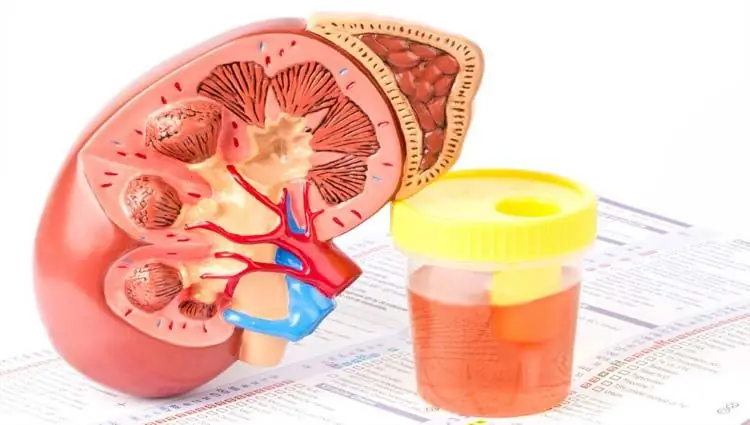- Author Curtis Blomfield [email protected].
- Public 2023-12-16 20:44.
- Last modified 2025-01-23 17:01.
Erythrocytes are microscopic cells present in human blood. They carry oxygen and carbon dioxide through the vessels and capillaries, carrying out one of the most important functions in our body - gas exchange. Their presence in the urine is permissible only in very small quantities, and an increased content may indicate that some organs are not working in the right way. Let's see what red blood cells in urine mean.
Urine as an indicator
Blood not only supplies organs and tissues with the necessary substances, but also takes away from them already used or undigested products. The kidneys filter it, returning what can be useful, and cutting off everything unnecessary, in order to then remove it from the body. Thus, the body gets rid of toxins, poisons, excess hormones and s alts, as well as simply useless particles that somehow ended up in it.
Due to the close relationship between the excretory and circulatory systems, urinalysis is one of the common ways to identify variouspathologies and disorders that exist within us. When any organs malfunction, extra cells or elements often appear in the blood, which then enter the fluids secreted by the body.
Elevated red blood cells in the urine is called hematuria, and has the same origin. This is not an independent disease, but just a symptom that appears due to many reasons. Sometimes they are temporary, purely physiological, in nature. In other cases, they may indicate a serious he alth problem.

Increase in the absence of pathology
Erythrocytes are very sensitive cells. They react to changes in the environment, a sudden change in habits or lifestyle, excessive stress on the body, etc. All this can lead to a change in the number of blood cells, however, when the effect of the negative factor ends, the cells return to normal.
Common physiological causes of high RBC counts in urine:
- prolonged exposure to heat or hot and stuffy rooms;
- abuse of spicy food and spices;
- alcohol intoxication;
- excessive physical labor, sports;
- menstruation;
- stress or nervous shock;
- taking anticoagulant drugs.

Other causes of hematuria
In most cases, if there is an excessive amount of red blood cells in the urine, this means that the body isinflammatory process, and the work of some systems is disrupted. Depending on the area in which the “malfunction” occurred, the following causes of hematuria are distinguished:
- Somatic or prerenal - red blood cells increase due to disease of organs that are not related to the urinary system. Among them: hemophilia, thrombosis, arteriovenous fistula, embolism of veins and arteries. These can be viruses, infections, parasites, poisoning, blood or immune problems, as well as diseases that occur with hemorrhagic syndrome.
- Renal - diseases or injuries of the kidneys, such as various tumors, cysts, stones, pyelonephritis, hemangioma, malformations of the kidneys, chronic or acute insufficiency.
- Postrenal - injuries and diseases that occur in the bladder and urethra, such as tumors, stones, ulcers, cystitis, urethritis, prostatitis.
Blood cells in the urine can appear as a result of primary organ damage, when hematuria is one of the main symptoms of the disease. With a secondary lesion, it occurs as a complication of a systemic disease. Another cause is genetic diseases such as Goodpasture's syndrome, Alport's syndrome, hereditary onychoarthritis, Fabry disease, systemic lupus erythematosus.
RBCs in the urine of women
The number of red blood cells in the urine varies, depending on the age and sex of the person. The standard way of checking involves a general clinical analysis, where they are counted by looking at the discharge directly through a microscope. In women, the norm is from zero to threeerythrocytes in the field of view. A change in the hormonal background cannot affect their behavior, therefore, even during pregnancy, their level should remain within the indicated limits. Exceeding the norm can be caused by diseases and disorders such as:
- cystitis;
- colpitis;
- cervical erosion;
- urethritis;
- urolithiasis;
- pelvic inflammatory disease;
- fibromyoma;
- malignant neoplasms.

Hematuria in men
For men, the rate of red blood cells in the urine is less than that of women. It is permissible that there be no more than one blood cell in the field of view. Diseases that affect the increase in their number are:
- urethritis;
- prostatitis;
- prostate adenoma;
- prostate abscess;
- vesiculitis;
- hemophilia;
- tumors in the genitourinary system.

RBCs in urine in children
Children's bodies develop very quickly and require more frequent examinations. Checking the presence of red blood cells in the urine of a child is recommended every year. In newborns, they should be no more than 6-7, at an older age - no more than 4-5.
An increased number of red cells may indicate dysmetabolic disorders associated with malnutrition. This happens when there are too many protein foods, preservatives, chocolate, or citrus fruits in the diet. They contribute to the deposition of s alts, whichinjure the urethra when they pass through them.
At an early age, red blood cells in the urine are often a sign of hereditary diseases or congenital disorders. Therefore, doctors must study the family history, paying special attention to records of coolagenosis, kidney disease, past infections, the presence of nephropathy, hematuria, hearing and vision pathologies in parents.

The most common causes of hematuria are:
pyelonephritis;
- urethritis;
- schistosomiasis;
- kidney tuberculosis;
- phimosis in boys;
- Berger's disease;
- Alport syndrome;
- Schönlein-Genoch jade;
- tumors;
- injuries;
- arteriovenous anomalies.
How does hematuria manifest?
In about 15% of patients, the presence of red blood cells in the urine is not felt in any way and is asymptomatic. In other cases, it is accompanied by discomfort, increased body temperature, pain or pain in the lower abdomen, frequent urge to urinate, whining in the lumbar region.
In addition, hematuria can appear against the background of general weakness, nausea, loss of appetite and increased fatigue. Various physical causes can cause high blood pressure, seizures, myalgia, anemia, hyperkalemia and hypernatremia, as well as other symptoms that are directly related to the underlying disease. Disorders of the urinary system are often accompanied by pain in the lower back, discomfort and discomfort in the lower abdomen andperineum, dysuria.
It is not always possible to determine whether red blood cells in the urine are elevated or not. If their concentration is higher than normal, but this is not visually manifested, then we are talking about microhematuria. In this case, it is possible to detect red bodies only with the help of analyzes and studies of fluid images. With gross hematuria, the number of red blood cells is so high that they color the urine pink or brown. Sometimes blood is present in it as small clots and specks.

Tests
Even a standard clinical analysis allows detecting red blood cells in urine, during which it is also checked for a number of other abnormalities. For him, the discharge is collected early in the morning in the middle of the process of urination. A clinical examination is done to check for any abnormalities.

The degree of the disease and its localization allow you to find out the following tests:
- Nechiporenko test - allows you to identify the exact number of blood cells. It is carried out after a general analysis has revealed that there is a problem. Urine in a test tube is placed in a centrifuge and mixed in it for several minutes, and then checked under a microscope. The number of erythrocytes found is multiplied by a coefficient. The norm of erythrocytes for analysis is 1000/ml.
- Kakovsky-Addis method - determines the daily fluctuation of erythrocytes, leukocytes and cylinders in the urine, finds out which cells are more. Based on this, you can find out which disease led to unpleasant symptoms. Urine sampling occurs during the day, the rate of erythrocytes foranalysis - no more than 1-2 million (1, 0-2, 0106/day).
- Three-glass test - allows you to detect in which area of the body a violation has occurred. The fluid of one urination is collected by the patient in three different containers, at different stages of the process. Depending on which test tube the level of erythrocytes will be increased in, one can draw a conclusion about the source of the problem. For example, in case of bladder disease, blood will be in the middle portion of urine, and in case of kidney damage, in the last portion.
For a more accurate picture and specific causes of hematuria, other examinations are carried out:
- Ultrasound of the urinary canals;
- Ultrasound of the abdominal cavity;
- kidney x-ray;
- MRI and CT of urinary organs;
- blood chemistry.
Preparing for tests
To prevent the test for red blood cells in the urine from giving a false result, a number of simple rules must be observed before analysis:
- Wait at least four days after your period.
- Reduce the amount of protein in the diet.
- Do not drink a lot of water the day before the test.
- Do not play sports, exclude physical activity, sauna or bath at least a day before passing urine.
- Do not take anti-inflammatory, antibacterial and diuretics for a day or two.
- Collect material in a clean container, preferably from a pharmacy.
- Rinse genitals thoroughly before harvesting.
- Take the material to the laboratory no later than two hours after collection, otherwise it will accumulate a lot of bacteria.
Treat and manage symptoms
Because an elevated red blood cell count is the result of more serious he alth problems, it is the source of the problem that needs to be treated. Reducing the level of red cells in the urine can only eliminate the symptom, and the effect will be short-lived if the disease itself is not eliminated.
All disorders that cause blood in the urine are quite dangerous and can easily become chronic. Therefore, it is desirable to respond to the symptom quickly and be sure to undergo all the tests prescribed by the doctor.






